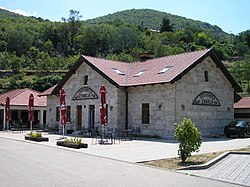
Summary
Zavala (Serbian Cyrillic: Завала) is a village in the Ravno municipality, in Bosnia and Herzegovina.
Zavala
Завала | |
|---|---|
Village | |
 | |
 Zavala | |
| Coordinates: 42°51′N 17°59′E / 42.850°N 17.983°E | |
| Country | |
| Entity | Federation of Bosnia and Herzegovina |
| Canton | |
| Municipality | |
| Area | |
| • Total | 3.94 sq mi (10.21 km2) |
| Population (2013) | |
| • Total | 186 |
| • Density | 47/sq mi (18/km2) |
| Time zone | UTC+1 (CET) |
| • Summer (DST) | UTC+2 (CEST) |
Geography edit
Zavala is situated in the south-western expanse of Popovo polje, within the southernmost reaches of Bosnia and Herzegovina. The village is also located approximately 400 meters away from the Vjetrenica cave. The village of Zavala also encompasses the hamlet of Mareva Ljut, contributing to the diversity and character of this geographical region.
History edit
Zavala was part of the medieval župa (county) of Popovo, mentioned in a charter issued by Grand Prince Miroslav of Hum to the Church of St. Peter by the Lim river at the end of 12th century. The village of Zavala was mentioned in a 1372 document. In the 14th century, Popovo was governed by the Nikolić noble family, and then the Sanković noble family. Throughout the 15th century, until the region fell to the Ottoman Empire, the Kosača family held possession of Popovo. The Klisura fort was built by the Kosača on the hills above Zavala in the early 15th century.
The Eastern Orthodox Zavala monastery was established around 1514. Two years later, in 1516, the Ottomans ordered the destruction of Catholic churches built before the conquest of Herzegovina. For this reason, many Catholics Catholics in Zavala converted to Eastern Orthodoxy. The proximity of the Zavala monastery was the main factor in their conversion.[1]
From 1961 to 1991, Zavala was the seat of the Zavala municipality.
Culture edit
- Zavala monastery, Serbian Orthodox monastery founded in the 16th century
Anthropology edit
The families of Zavala before the Yugoslav wars were the Vukanović, Korać, Čalank, Andrić, Jović, Srba, Šešelj,[2] Tupajić, Turanjanin, Nedić, Vulić. These have mostly left for Trebinje.
Demographics edit
In the 1991 census, the village itself had 105 inhabitants, of whom 89 were ethnic Serbs, 12 Croats, and 4 Yugoslavs.
According to the 2013 census, its population was 186.[3]
| Ethnicity | Number | Percentage |
|---|---|---|
| Croats | 143 | 76.9% |
| Serbs | 43 | 23.1% |
| Total | 186 | 100% |
Footnotes edit
- ^ Vidović 2010, p. 285.
- ^ "24sata.info - Šešeljev rođak: Vojislav je često dolazio u Marevu Ljut sa Aleksandrom Vučićem". Retrieved 30 January 2016.
- ^ "Naseljena Mjesta 1991/2013" (in Bosnian). Statistical Office of Bosnia and Herzegovina. Retrieved October 22, 2021.
References edit
Journals edit
- Vidović, Domagoj (2010). "Pregled toponimije jugozapadnoga dijela Popova" [Overview of the toponymy of the southwestern part of Popovo]. Folia onomastica Croatica (in Croatian) (19): 17–33. Retrieved 20 February 2024.
External links edit
- rtrs.tv: Огњишта › Дубљани и Завала


